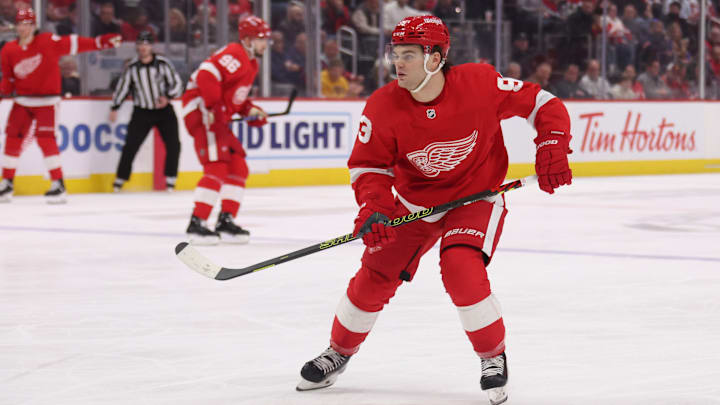Last summer, Detroit Red Wings general manager Steve Yzerman made a blockbuster trade within the Atlantic Division to land star winger Alex DeBrincat.
DeBrincat, 26, is entering the prime of his career and immediately signed a lucrative contract extension to remain with his hometown Red Wings for the foreseeable future. The four-year deal averages $7.875 million annually.
The crafty winger enjoyed a solid first year with the organization and was a big reason why future Hall of Fame forward Patrick Kane elected to join the Red Wings and why he decided to sign a one-year deal to remain in Detroit earlier this summer. Despite a nine-year age gap, the two quickly became inseparable on and off the ice, dating back to their time together in Chicago. Kane and DeBrincat's skill sets complement one another well despite some defensive deficiencies while playing together in even-strength situations.
You've probably seen the amazing videos of DeBrincat walking out toward the rink at Little Caesars Arena to begin pregame warmups and stopping to greet not only his own family but also Kane's. The same thing happens for Kane; often, neither of the kids is wearing their father's jersey but the jersey of their dad's best friend.
Consistency will be the key for Alex DeBrincat in 2024-25.
In his first season with the Detroit Red Wings, the top-flight winger recorded 27 goals and 67 points over 82 games. Although the overall numbers look fine, DeBrincat did lack consistency at times, scoring nine goals in the first seven games of the season and totaling 17 goals and 38 points over the first 41 games. It doesn't take a genius to do the math: that means he tallied ten goals and 29 points during the second half of the year, and down the stretch, when Detroit remained firmly in the playoff hunt, DeBrincat managed a mere four goals over the final 22 games of the regular season.
One thing that stood out last season was the number of times DeBrincat rattled the goal-post. For a stretch, it seemed like every other one of his shot attempts drew the iron. Another stat that stood out a bit was his shooting percentage of 11.4 last season. That number was up from his 10.3% the year prior in Ottawa but significantly lower than his final two seasons with the Blackhawks, where he achieved a 20.6 and 15.2% success rate.
Asking a player to maintain a 20% shooting rate is unfair, but if DeBrincat can get back around the 13-15% would have put DeBrincat's goal total in the mid-30s last season. Also, the sniper needs to simply shoot more, which won't help the rate, of course, and may hinder it, but there would be at least more volume. DeBrincat recorded 237 shots last year, which was significantly below his 270 and 263 shots in the previous two seasons. In comparison, Dylan Larkin maintained a 14.9% shooting percentage last season; the league's top goal scorer, Auston Matthews, produced a stellar 18.7% rate.
Last year DeBrincat maintained a Corsi For Percentage of 50.0 paired with a career-best Relative Corsi For Percentage of 5.5 during even strength situations. That, along with an expected goal differential of +1.9, continues to impress. I expect to see a more consistent effort from DeBrincat next season, and he'll be a lot more comfortable playing alongside Larkin and Lucas Raymond on Detroit's top line, hopefully pacing this organization to their first playoff berth after a lengthy eight-year drought. It feels like we can pencil in Larkin, Kane, and Raymond being point-per-game contributors, and if DeBrincat can join them in that club, the Red Wings will likely take a step forward.
